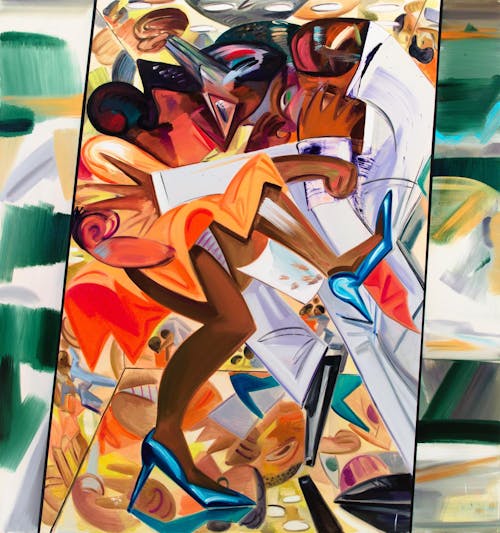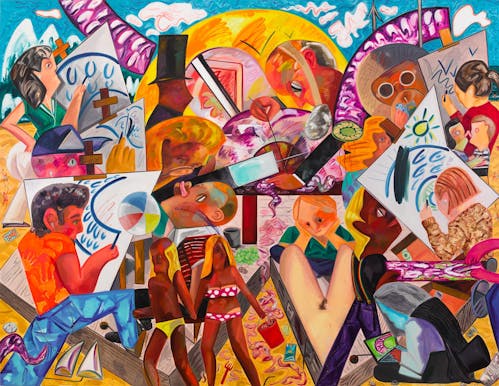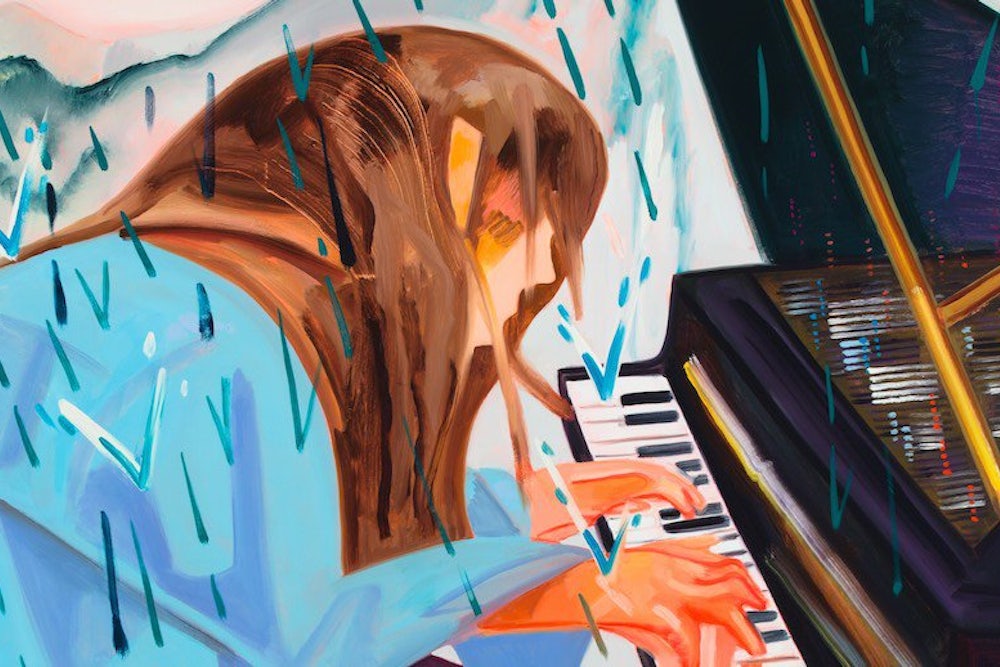As fame grows, it flattens. Our celebrities might be more vocal, more progressive, and more constantly accessible than they ever might have been in past eras. But the stars are as iconic as ever: Caitlyn Jenner brought international visibility to trans rights in a single cover shoot. Beyoncé is so famous she doesn’t even communicate in words to her public, which results in surreal stunts like gifting her fans a word-association cloud. Kim Kardashian’s selfies are, at this point in history, better known than any photographer’s portrait of her.
Flat, however, doesn’t mean shallow. Compression can be a good thing. When everything is on the same plane, moving through the same media, connections can happen instantaneously, uniting viewers across the world. The right picture is a more potent vehicle for mass communication than ever before, no matter its source or format—two qualities that matter less than ever as images are also robbed of context online.
The painter Dana Schutz is at home here, in this milieu. For over two decades, Schutz has used her canvases to picture outlandish and impossible situations—a telephone booth on the side of a highway at the end of the world; a frantic face smoking, swimming, and crying all at the same time; a figure eating its own face—restoring character and story to an art scene addicted to figure-less abstraction.
Now, in our annus kardashianis, the world outside has grown to resemble her work. The outsized stories she tells, like those of David Foster Wallace or the convoluted dramas of Mad Men, have become our own.

Schutz’s new show, which just opened at Chelsea’s Petzel Gallery to kick off the fall season (on view through October 24th), is called “Fight in an Elevator,” after the infamous incident involving Solange and Jay Z. The eponymous painting, hanging larger-than-life on the wall, is a breathtaking whirl of white and orange against the gray-green sheen of the metal doors opening as if onto a stage set. Solange’s bright-blue heels kick at Jay’s white suit. Their faces swirl into unreadability except for the reflections bounced back by the elevator walls and floor.
The pop resonance contributed to the painting’s popularity as well as its painterly Futurism. In the packed gallery, it attracted the biggest crowd.
The painting Fight in an Elevator itself matches the actual fight’s ridiculous grandeur, stemming from the participants’ own glamour as well as the sudden visibility of the violence. We still don’t know why it happened, but we went apeshit over it anyway, our eyeballs glued to pixelated elevator surveillance tapes blown out across the Internet.
As it happens, painting has also flattened over the past century: from Picasso’s Cubism, to Clement Greenbergian abstraction, to the recent mixture of figuration and abstraction critic Walter Robinson deemed “zombie formalism.” While the emphasis on the abstract may have shifted—first intensifying and more recently lessening—narrative is only just returning to the medium, thanks in large part to Schutz’s influence.

Schutz’s origin story has already become legendary. After getting her MFA at Columbia in 2002, her first exhibition, “Frank from Observation,” opened that year at the wunderkind dealer Zach Feuer’s first gallery. In it, a series of paintings depicted Schutz as the last painter in the world, painting Frank, her final subject. Frank eats eyeballs, splays on the beach, wanders into an apocalyptic jungle. With that debut, she quickly became one of Feuer’s first stars, catapulting into many collections, if not necessarily earning the mainstream attention accorded Jeff Koons or Damien Hirst.
Since 2002, Schutz’s apocalyptic world has expanded, but it has never lost its initial crazed creativity—she works as if she truly is the last living painter. A few favorites: Teeth scraping deck wood; a woman giving birth while staring at a Hudson River Valley School painting; the imagined autopsy of Michael Jackson; a musician pounding a piano in heavy rain; a canvas simply titled Licking a Brick, which is literally what it sounds like. Schutz’s images tumble ceaselessly from her brush.
Painters’ painters often make art about making art, since insiders are supposed to get the jokes and subtleties—the same with writers’ writers. Schutz’s work, as with the late painter Philip Guston, whose work moved from non-objective abstraction to narrative figuration, can often be read as a metaphor for studio practice. Indeed, in Schutz’s current exhibition, there’s an enormous quasi-Cubist piece called Assembling an Octopus, which compresses an entire figure drawing class onto a beach, ringed around a dissected cephalopod. The image coalesces even as it falls apart; each artist stares at a figure or paints a representation of the octopus carcass.
But Schutz herself pursues larger subjects. “The hypotheticals in the paintings can act as surrogates or narratives for phenomena that I feel are happening in culture,” she told BOMB magazine in 2006. One canvas in the show pictures a woman reminiscent of Rihanna in a yellow Adidas shirt. Swiss Family Traveling depicts a lost group of European tourists straight out of Williamsburg, Brooklyn.
In this rangy engagement with culture—as it exists on the street as well as art history—Schutz resembles no artist more than Max Beckmann, whose darkly glamorous tableaus of pre- and post-WWI society today maintain a breathtaking, terrifying vitality.
Schutz adopts the tactics of modernism—the rupture of abstraction and the flattening of the image—which makes sense in a world less driven by ideas than by stories. It’s painting for Donald Trump: a man who, more than any other, might be described as constantly eating his own face.
If Schutz’s pictures are cultural allegories, they embody the difficulty of attempting to live as an individual—anyone can go viral and be cast suddenly into the spotlight, into the middle of the frame. Schutz’s brushstrokes, correspondingly, have been getting thinner and faster over the years. Now, a work like Lion Eating Its Tamer, which is also what you think it is except the consumption is an essay on geometry, speeds like the shifting image on a TV screen or the endlessly repeating frames of a GIF.
But there is little cynicism there. Schutz has a deep faith in art’s ability to help us claim our enduring humanity. “Can I live?” Kim Kardashian asked rhetorically. Yes, Schutz’s art suggests, we can.
Photos of Solange after the elevator fight show an uneasy détenté between all parties. Jay and Beyoncé and her sister look by turns embarrassed and annoyed. Usually you can only see the whole frame if you watch the video over and over again, teasing out its details. Schutz’s painting, however, manages to capture the whole thing and its media drama at once.
What’s more, with art’s ability to outlast other artifacts, it’s likely to become the image that survives. A painter’s canvas might have a far longer afterlife in a museum gallery than an already-degrading digital artifact. This is how we’ll be remembered.
